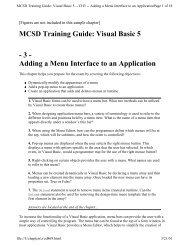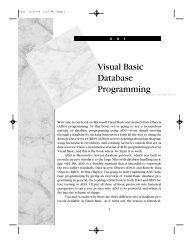3.0—Home Security and Surveillance Systems
3.0—Home Security and Surveillance Systems
3.0—Home Security and Surveillance Systems
Create successful ePaper yourself
Turn your PDF publications into a flip-book with our unique Google optimized e-Paper software.
128<br />
Chapter<br />
................................................<br />
3<br />
A home security <strong>and</strong> surveillance system is an essential part of any modern<br />
automated home. The basic design of a security system begins with analyzing<br />
the needs of the inhabitants, surveying existing technology <strong>and</strong> hardware,<br />
reviewing system costs, considering monitoring choices, <strong>and</strong> finally planning<br />
the installation.<br />
In addition to perimeter <strong>and</strong> interior protection offered by a security system,<br />
surveillance monitoring includes features that enable the inhabitants to<br />
observe environmental conditions inside <strong>and</strong> outside the home when at<br />
home or away.<br />
In a home surveillance system, video cameras <strong>and</strong> display systems are considered<br />
by most contractors to be optional items. Subject to the homeowner’s<br />
choice, surveillance equipment can function independently from the<br />
basic features included in home security monitoring.<br />
This chapter provides the information you will need to know as a home integrator<br />
for designing, integrating, <strong>and</strong> installing a home security <strong>and</strong> surveillance<br />
system.<br />
Design Considerations<br />
The design of a security <strong>and</strong> surveillance system should provide for the protection<br />
of the entire perimeter of a home as well as visual- <strong>and</strong> audio-based<br />
surveillance monitoring. <strong>Security</strong> system sensors are available that are<br />
designed to detect sound, window <strong>and</strong> door intrusion, air movement, body<br />
heat, motion, <strong>and</strong> other conditions that indicate an intruder is present. A<br />
good security system design should consider the best plan for existing homes<br />
as well as new construction. It should also consider the lifestyle of all the<br />
inhabitants, the location of valuables or any items to be protected, how the<br />
system is to be controlled, adequate smoke <strong>and</strong> fire alerting sensors, <strong>and</strong> the<br />
type of emergency response required. The design choices are numerous <strong>and</strong><br />
varied due to advances in home security technology <strong>and</strong> the wide availability<br />
of compact, low-cost video surveillance systems.<br />
Wireless <strong>Security</strong> <strong>Systems</strong><br />
Wireless home security systems use battery-powered radio transmitters<br />
<strong>and</strong> receivers to connect the various components such as cameras, sensors,<br />
area motion detectors, sirens, central controllers, smoke/fire detectors,<br />
keypads, <strong>and</strong> video displays. These types of security systems are usually<br />
available at a local hardware store or on the Internet <strong>and</strong> are often designed
















